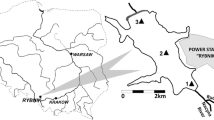Abstract
Two methods of environmental toxicological tests were compared and applied to bed sediments of the Anllóns River: the standardized toxicological test based on inhibition of luminescence employing Vibrio fischeri, and a phytotoxicity test, using garden cress (Lepidium sativum L.), water cress (Nasturtium officinalis L.) and annual rye-grass (Lolium multiflorum L.) seeds. In addition, TCLP and HCl extracts were evaluated. The inhibition of luminescence test showed more sensitivity to toxicants than phytotoxicity assays, and no significant correlations were found between them. On the other hand, TCLP metal concentrations (Fe, Al, Zn, Pb, As) were lower than HCl concentrations, but seemed to represent more accurately the phytoavailability of metals to plants.

Similar content being viewed by others
References
Bedell JP, Briant A, Delolme C, Perrodin Y (2003) Evaluation of the phytotoxicity of contaminated sediments deposited “on soil”. I. Impact of water draining from the deposit on the germination of neighbouring plants. Chemosphere 50(3):393–402
Bennet J, Cubbage J (1992) Evaluation of bioassay organisms for freshwater sediment toxicity testing. Washington State Department of Ecology, Olympia, WA
Chen YX, Zhu GW, Tian GM, Zhou GD, Luo YM, Wu SC (2002) Phytotoxicity of dregded sediment from urban canal as land application. Environ Pollut 117(2):233–241
Emino ER, Warman PR (2004) Biological assay for compost quality. Compost Sci Util 12(4):342–348
Fuentes A, Lloréns M, Sáez J, Aguilar MA, Pérez-Marín AB, Ortuño JF, Meseguer VF (2006) Ecotoxicity, phytotoxicity and extractability of heavy metals from different stabilised sewage sludges. Environ Pollut 143(2):355–360
Guzzela L (1998) Comparison of test procedures for sediment toxicity evaluation with Vibrio fischeri bacteria. Chemosphere 37(14–15):2895–2909
Hosokawa M, Endo G, Kuroda K (1995) Acute toxic effect of river yodo water (Japan) on Daphnia magna. B Environ Contam Tox 55(3):419–425
Keller AE (1993) Acute toxicity of several pesticides, organic compounds, and a wastewater effluent to the freshwater mussel, Anodonta imbecilis, Ceriodaphnia dubia and Pimephales promelas. B Environ Contam Tox 51(6):696–702
Moalla SMN, Soltan ME, Rashed MN, Fawzy EM (2006) Evaluation of dilute hydrochloric acid and acid ammonium oxalate as extractants for some heavy metals from Nile River sediments. Chem Ecol 22(4):313–327
OECD (1984) Guideline of the OECD for testing chemical products – terrestrial plants. Growth Test – Method #208, Paris, France
Párvez S, Venkataraman C, Mukherji S (2006) A review on advantages of implementing inhibition test (Vibrio fischeri) for acute toxicity prediction of chemicals. Environ Int 32:265–268
Snape I, Scouller RC, Stark SC, Stark J, Riddle MJ, Gore DB (2004) Characterisation of the dilute HCl extraction method for the identification of metal contamination in Antarctic marine sediments. Chemosphere 57:491–504
MOPU (1989) Spanish ministry of public works and town planning, About characterization methods of toxic and dangerous residues. Official Spanish Bulletin (BOE) 270
USEPA (1992) Method 1311: toxicity characteristic leaching procedure (TCLP). US Environmental Protection Agency, Washington, DC
Utz LRP, Bohrer MBC (2001) Acute and chronic toxicity of potassium chloride (KCl) and potassium acetate (KC2H3O2) to Daphnia similis and Ceriodaphnia dubia (Crustace, Cladocera). B Environ Contam Tox 66:379–385
Warman PR (1999) Evaluation of seed germination and growth tests for assessing compost maturity. Compost Sci Util 7(3):33–37
Zucconi F, Monaco A, Forte M, De Bertoldi M (1985) Phytotoxins during the stabilization of organic matter. In: Gasser JKR (ed), Composting of agricultural and other wastes. Elsevier, London, pp 73–85
Acknowledgments
The present study was financed by the Science and Education Ministry of Spain, which granted Rosa Devesa with a FPI grant (MEC, REN 2003-08673/BES-2004-5894). The authors wish to thank two anonymous reviewers for their helpful comments, which substantially improved this manuscript.
Author information
Authors and Affiliations
Corresponding author
Rights and permissions
About this article
Cite this article
Devesa-Rey, R., Moldes, A.B., Díaz-Fierros, F. et al. Toxicity of Anllóns River Sediment Extracts Using Microtox and the Zucconi Phytotoxicity Test. Bull Environ Contam Toxicol 80, 225–230 (2008). https://doi.org/10.1007/s00128-007-9350-0
Received:
Accepted:
Published:
Issue Date:
DOI: https://doi.org/10.1007/s00128-007-9350-0




